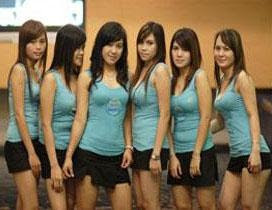 A list of some things that are not as Indonesian as you thought:
A list of some things that are not as Indonesian as you thought:
1. Sambal. I love sambal. But how Indonesian is it? Well, not much. Cos chili peppers are indigenous to the Americas, and were brought here by European sailors in the 16th century. But before too long, chili peppers were quickly incorporated into the Indonesian cuisine.
2. Bahasa Indonesia. Really? When are the Aussies gonna start speaking Bahasa Australia?
 3. Wayang. So incredibly and intrinsically Indonesian, Wayang shadow theatre features stories about, er, Indian characters like Bima, Rama and Sinta!
3. Wayang. So incredibly and intrinsically Indonesian, Wayang shadow theatre features stories about, er, Indian characters like Bima, Rama and Sinta!
4. Dangdut. The kampung beat ain’t nothing more than a gaudy synthesis of Arabic and Indian music, with dashes of Latin, house, hip-hop, R&B, reggae, and even Western classical music thrown in.
5. Kebaya. How very Javanese. But not quite. The Kebaya originates from Arabia – the Arabic word of Kaba means clothing. The kebaya was brought over to this part of the world by the Portuguese in the 15th century, and soon became popular among the Javanese nobles.
 6. Bajaj. The definitive Indonesian motorized three-wheel vehicle as seen in Jakarta. Made in Maharashtra, India.
6. Bajaj. The definitive Indonesian motorized three-wheel vehicle as seen in Jakarta. Made in Maharashtra, India.
7. Bogor’s Botanical Gardens. Very nice but not very Indonesian. The brainchild of Sir Stamford Raffles, Java’s governor from 1811-1816, the creation of the gardens was overseen by the German-born Dutch botanist, Professor Casper George Carl Reinwardt.
8. Religion. The Indian ships sailed over and brought Hinduism and Buddhism. Wonderful temples like Borobodur and Prambanan were built. Later it was the turn of Arab traders to spread the word, and finally, of course, the European colonialists who had a fair measure of success in bringing Christianity to places like Nias, Lake Toba, Flores, Ambon, Manado and even Papua.
9. Freedom Palace in Jakarta (Istana Merdeka). Built by you-know-who.
Yeah heritage is nice. But don’t press the point. Else you might end up with egg on your face.
Anyone for a Beer Bintang?
NB: Here’s a couple more I’ve thought of:
10. Kecak: best known as the Ramayana Monkey Chant. Obviously an authentic Balinese drama, right? Well, not exactly. The truth is that it was created by Wayan Limbak and the famous German painter Walter Spies in the 1930s to pander to the narrow tastes of Western tourists of the time. The foreign tourists of course loved it and Wayan Limbak realized the show had great potential. So he went to major cities across the world with Balinese performance groups, winning over audiences and making kecak internationally famous. Job well done.
11. Indonesia – Yep the name of the country itself! This is pointed out by OG Roeder in his rather obsequious yet amusing little book called “Indonesia – a personal introduction”, in which he writes that the word Indonesia “has been compounded by combining two Greek words – indos meaning India and nesos meaning islands".







Too funny.
ReplyDeleteBorobudur and Angkor Wat:
ReplyDeleteThank you for hosting.
Can anyone out there shed more light on the origins of the link between these 2 iconic Indo-Chinese civilizations that are prevelant throughout this area.
My personal view on this is that much of what is
Khmer is the result of a Javanese 'export' of its
culture and know how in ancient times and not just a simultaneous and independent outgrowth of trade between India and China.
The seasonal winds of the north-east and south-west monsoons and geographical locations of Cambodia and Java would imply that ancient sailors could transverse these 2 areas in the most efficient and direct routes going with the winds.
As a result there are many similarities of architecture, culture, written and spoken language between the 2 groups.
Javanese and Cambodians (who are distinctly darker in complexion than their neighbours the Vietnamese or even the Thais)look so similar.
Today, there are possibly 150million Indonesians of Javanese ancestory and 20million Cambodians,
would it therefore be conceivable that the Khmers
were actually ancient Javanese explorers who soon after brought along their 'exports.'?
Tigerpuran